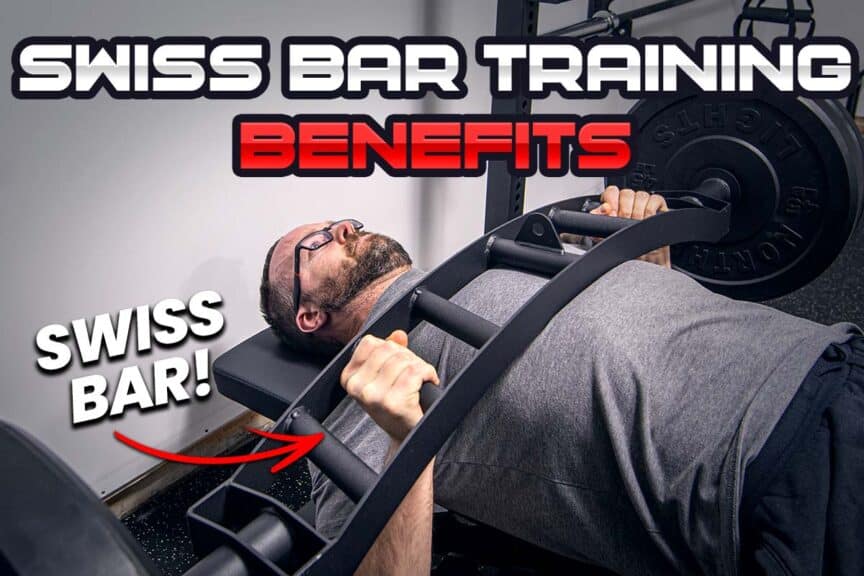You’d think weightlifting and strength training equipment wouldn’t get as complex as it sometimes seemingly does; all you need is a barbell and some weights, right? Yet gyms of all types (commercial gyms, private, and home gyms) are becoming increasingly filled with different types of specialty training equipment, with specialty barbells being one such example.
The Swiss bar (often called a multi-grip bar) is one type of specialty barbell that lifters often have questions about. Does it really have any purpose or unique benefits? Is it really worth performing bench press or rowing exercises with this peculiar-looking bar, or should you opt for training with a traditional barbell instead?
This article will break down the basics of what a Swiss bar is, the benefits it can offer when incorporating multi-grip training into your workouts, the best exercises to perform with the Swiss bar, and how doing so can take your training to new levels while reducing your chances of aches, pains, and injuries.
Alright, enough with this introduction. Let’s get down to business!
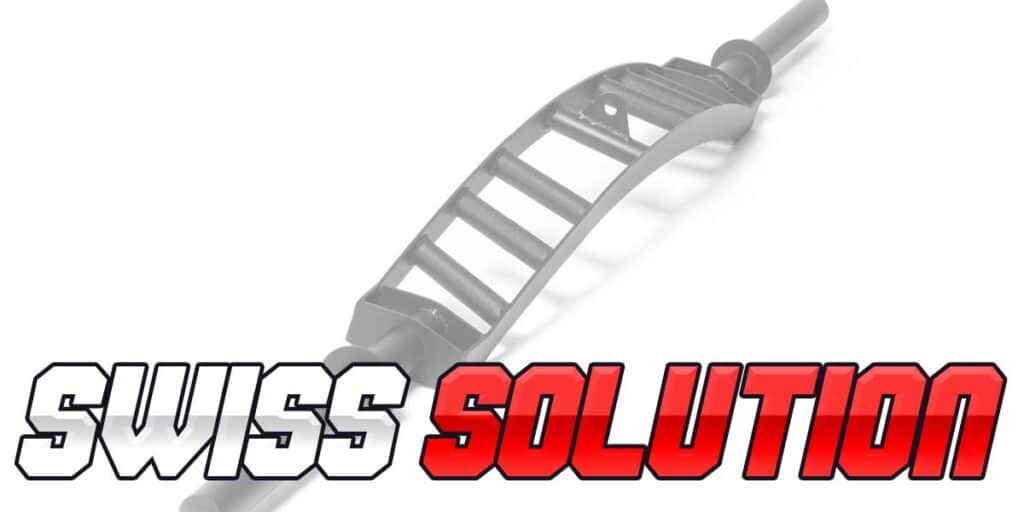
What is a Swiss bar?
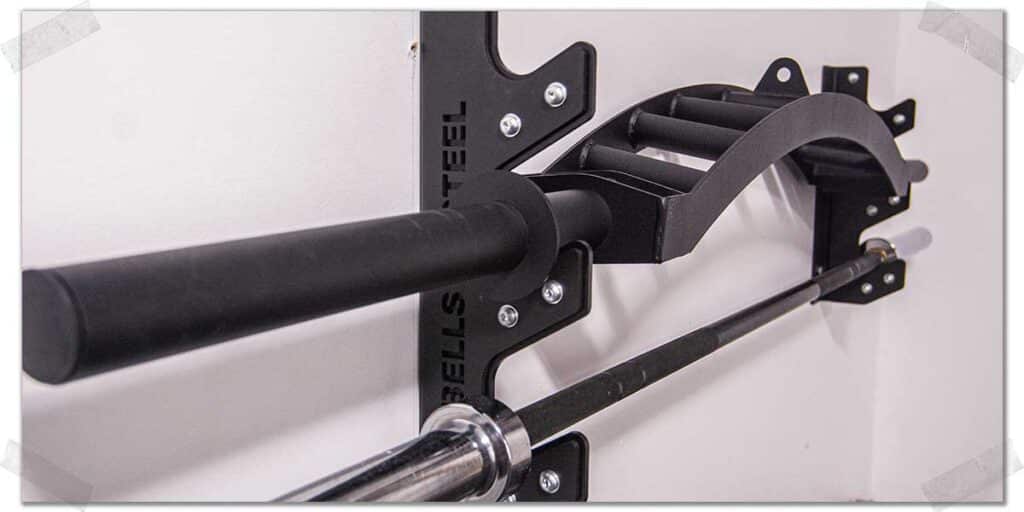
A Swiss bar goes by a few different names, so it’s worth knowing it is also commonly referred to as:
- A multi-grip barbell
- A football bar
- The Arch Nemesis bar (this is a specific type of Swiss bar made by Bells of Steel)
Regardless of which name you give it, a Swiss bar is a type of barbell consisting of multiple vertical handles (spaced out across the bar), which allows traditional strength training exercises to be performed in a slightly different manner than with a traditional straight barbell.
To help you become familiar with these names, I will use each one interchangeably throughout this article. Remember, they all refer to the same type of bar.
Benefits: Why use a multi-grip barbell?
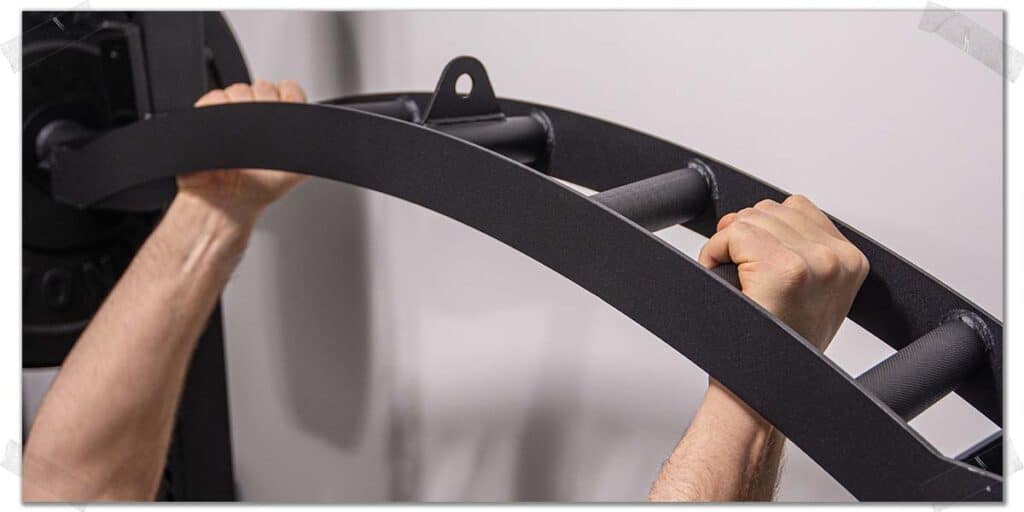
Whether you’re a bodybuilder, a football player (or other athlete), or an average Joe looking to build some upper body strength, there are plenty of benefits to be had when using a multi-grip bar for your strength training workouts.
This type of bar isn’t only for advanced lifters and competitive strongmen. In fact, the Swiss bar holds unique benefits that are equally as beneficial for beginners (and in some ways, even more so) as they are for advanced lifters.
Ultimately, the benefits of training with a Swiss bar come down to the different hand positions the bar provides. Since the multiple handles on the Swiss bar run perpendicular to a traditional barbell, any exercise you perform will be done with a neutral grip (meaning your palms are facing one another).
And with the utilization of a neutral grip comes some rather distinct and profound training benefits that can improve your performance in more ways than one!
Pro tip: If you don’t have access to a multi-grip bar, you can always opt to use dumbbells since they will allow you to rotate your hands into the same neutral-grip position. There are some subtle differences that can arise, but dumbbells work well. The only drawback may be that you don’t have access to dumbbells that go heavy enough for your exercise needs.
Here are some universal benefits that almost any athlete or non-athlete can experience when incorporating multi-grip barbell exercises into their training regimen:
Benefit 1: Different muscle emphasis
The human body is so intricate and complex that even a small change in physical position during an exercise can result in different muscles being utilized or emphasized over others. The Swiss bar makes explicit use of this phenomenon. These differences are most commonly
implemented for two particular exercises:
- Pressing exercises
- Pulling exercises
Let’s look at a quick example of each!
Muscles emphasized during bench press with the Swiss bar
The traditional barbell bench press utilizes an overhand grip, which places a lifter’s arms in a position that primarily targets the pectoral muscles, anterior deltoid (front shoulders) muscle fibers, and the triceps brachii muscles.
The multi-grip bar will still utilize all three of these muscles as well; however, due to the subtle change in arm positioning (i.e., using a neutral grip), the triceps muscles will be utilized to a slightly greater extent during the press, making it a perfect option for lifters who want to target their triceps more so than with a traditional barbell.
Muscles emphasized during rows with the Swiss bar
When it comes to contrasting rowing exercises with a Swiss bar to those of a traditional barbell, different muscles along your back are emphasized more so than others (just as they were with pushing or pressing exercises).
To be clear, all major muscles of your back will be involved in helping you complete your rows, regardless of the type of bar being used. That being said, the neutral grip afforded by a multi-grip bar will often place more emphasis on the rhomboid muscles and middle trapezius muscle fibers due to the greater extent of scapular (shoulder blade) retraction (squeezing) that can take place when in the neutral-grip position.
Additionally, your biceps and your brachioradialis (a muscle in your forearm) are involved to a much greater extent when rowing with a neutral grip than with an overhand grip, making it a perfect option for those who want to train their back and biceps at the same time.
Benefit 2: It can save your shoulders from pain and injury
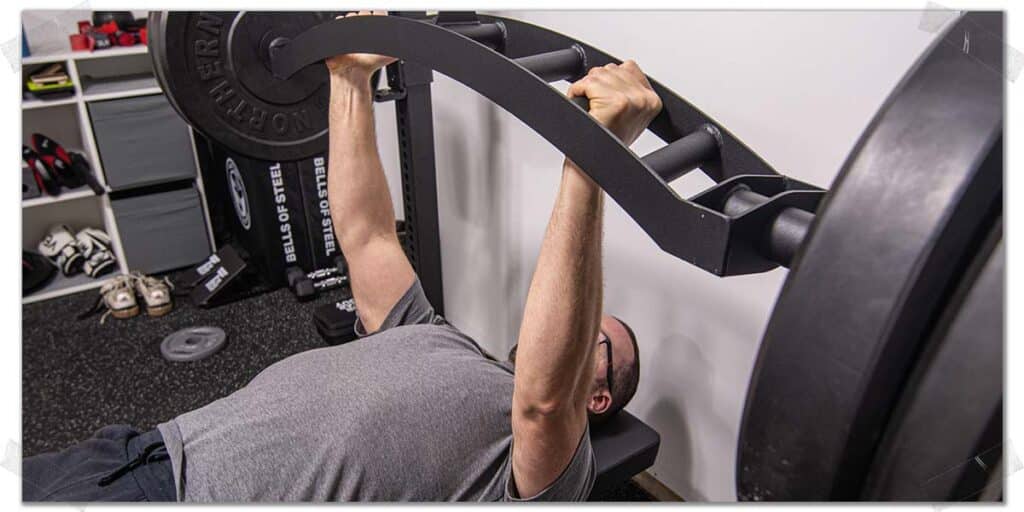
Many individuals—competitive and non-competitive alike—are prone to experiencing various types of shoulder dysfunction, be it from training with heavy weight, previous injury, poor movement control, muscular imbalances, etc., all of which can lead to aches, pains, and lousy strength training sessions. (It’s hard to train hard when your shoulder is a hot mess, ya know?)
The Swiss bar bench press is arguably the most commonly performed exercise with a multi-grip barbell (you’ll learn more about why in the following section of this article) for multiple reasons. In addition to the benefits the multi-grip bar provides listed in Benefit 1, the neutral-grip position afforded by the bar is often less physically taxing on the shoulder joint (known as the glenohumeral joint), the acromioclavicular joint (or AC joint, for short) and subsequent shoulder muscles.
Whether you’re performing pushing exercises (such as bench press) or pulling exercises (such as bent-over rows), the neutral grip will place the upper arm (the humerus bone) in a slightly different position than when holding a traditional barbell.
RELATED CONTENT:
It may not seem like much of a difference, but if you know your anatomy, you know it makes a profound difference on humeral head positioning and subsequent capsular and soft tissue (i.e., muscle and tendon) positioning, especially when pressing or pulling heavier loads.
This can reduce chances of incurring annoying and painful conditions such as long head of biceps tendonitis, tendinosis, muscle strains, and generalized irritation of any muscles, tendons or joints involved with your exercises.
Benefit 3: It’s a highly versatile piece of training equipment
Getting the biggest bang for your buck is a top priority of any gym owner or home gym enthusiast; nobody wants to spend money on a piece of fitness equipment that can only be used for a single exercise, especially if it takes up valuable floor space.
A Swiss bar not only takes up minimal amounts of floor space (yes, it’s perfect for small home gyms), but it also offers high training versatility. It can be used for numerous pushing and pulling exercises—far more than the more common exercises mentioned in this article.
Personally, having a Swiss bar in my home gym has been incredibly enjoyable as I now have the option to perform heavy neutral-grip bench press with weight beyond what I have access to with my adjustable dumbbells (I have the Powerblock Pro Exp’s, and I love them).
The same goes with neutral grip rows; I can load up much heavier weight when looking to perform some back training than I otherwise could with my Powerblocks.
Benefit 4: More natural feeling movement
This may sound like a beginner’s benefit for utilizing a Swiss bar, but it applies just as much to advanced lifters, gym-goers, and other athletes as anyone else.
Beginners often find that it’s easier to control a bar when using a neutral grip than with the overhand grip afforded by a traditional barbell. This is most notable when it comes to controlling bar path on the bench press.
Anecdotally, I can attest to this; when working with many novice lifters in the gym, I find they often have significantly better bar control with the neutral grip than the overhand grip, notably with pressing exercises.
Advanced lifters (including myself), while able to exhibit pristine movement control with a traditional barbell, often find that controlling bar path with a multi-grip bar comes more naturally (or perhaps just feels more comfortable) than with a traditional straight bar.
RELATED CONTENT:
Benefit 5: More sports-specific movement
While this benefit doesn’t pertain to every lifter, it certainly comes in handy for any athlete whose sport requires upper-body pressing movements similar to what the Swiss bar bench press offers.
Football linemen are the perfect example, as their position demands a very similar movement. Other athletes, such as rugby players and wrestlers (among others), can also benefit from incorporating neutral-grip press and pull exercises into their training to help ensure sport-specific crossover from their training to their sport.
Whether the exercises are performed in a slow, controlled manner or quickly in an explosive manner (which tends to be more sport-specific), the arm positioning incorporated from neutral-grip exercises is often very beneficial for athletes.
The best Swiss barbell exercises to build strength & muscle
While a Swiss bar can be used for numerous exercises, it’s most commonly used for compound (multi-joint and multi-muscle group) exercises, such as bench press, rows, and overhead press (military press).
Compound exercises should be the foundation for any athlete or individual looking to add size and strength to their body, as these types of exercises stimulate multiple muscles or muscle groups at the same time.
Let’s look at some of the most commonly performed exercises with the Swiss bar, why they’re so effective, and why you should consider incorporating them into your training.
Exercise 1: Neutral grip bench press
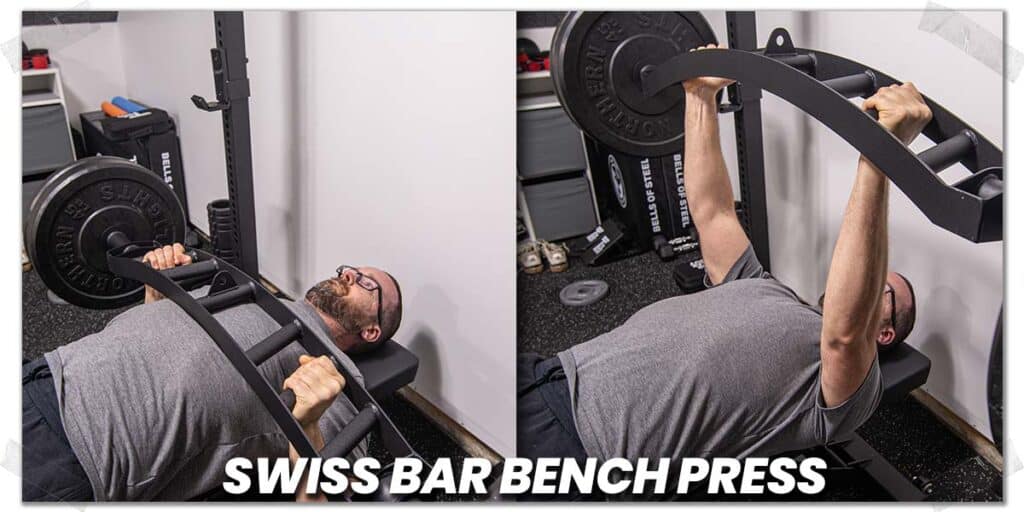
Swiss bar bench press will target the muscles on the front of your upper body in the same manner that a traditional barbell would, which includes:
- The pectoralis major muscle
- The triceps muscles
- The anterior (front) deltoid muscle fibers
The primary difference is that there will be a greater emphasis placed on the triceps muscles due to the upper arms’ orientation when grabbing and holding the Swiss bar.
Additionally, the more narrow your grip, the greater emphasis you’ll place on your triceps when performing the press.
Related article: Why the Sphinx Push-up Reigns KING for Triceps Strength and Size
The wider the grip, the greater emphasis you’ll place on your pectoral muscles.
However, to be clear, each previously mentioned muscle group will still undergo extensive stimulation when performing the movement.
Exercise 2: Neutral grip bent-over rows
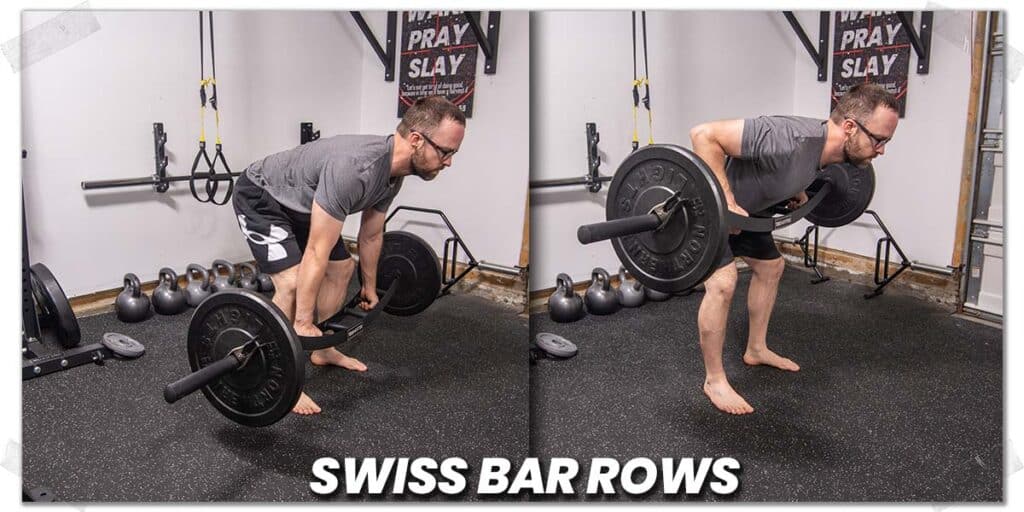
Bent-over Swiss bar rows are just as easily performed with a traditional barbell, but again, due to the different hand orientation involved, the humeral head (the “ball” of the ball and socket joint of the shoulder) is in a slightly different position when using the Swiss bar, allowing muscles on your mid and upper back to be targeted in an ever-so-slightly different manner.
Bent-over rows are kind of like a nuclear bomb for the back in that they target pretty much everything and leave no muscle untouched.
As such, they’re the perfect exercise for targeting your:
- lats (the latissimus dorsi muscle)
- rhomboids
- posterior (backside) deltoid fibers
- middle trapezius fibers
- smaller accessory muscles along your backside.
Additionally, maintaining the bent-over position during the Swiss bar row forces the erector spinae muscles (muscles along your lower back) to work aggressively to keep you from collapsing further forward at the waist.
Exercise 3: Neutral grip overhead press
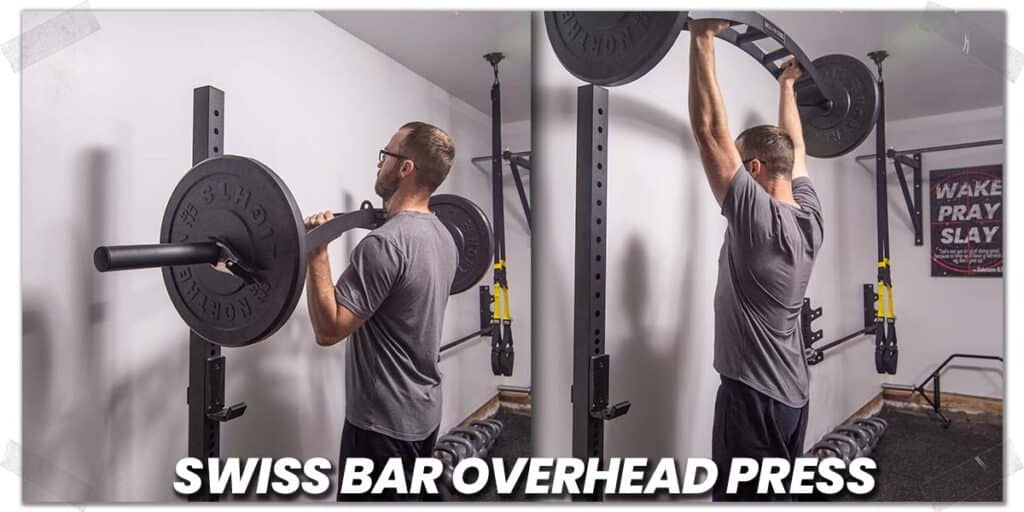
When it comes to barbell training, the overhead press is one of the “classic lifts” that can be performed.
The overhead press will target:
- The deltoid muscle (all three fiber bands)
- The triceps
- The upper trapezius muscle fibers
I always like performing my overhead presses with a slightly staggered stance, as this helps to prevent “cheating” the movement. Cheating the movement allows the lower back to arch in a manner that can often be irritating and cause pain to the lower back region.
It’s best to perform this exercise by lifting the bar from shoulder height in a squat rack rather than from off the floor.
Exercise 4: Hammer curls
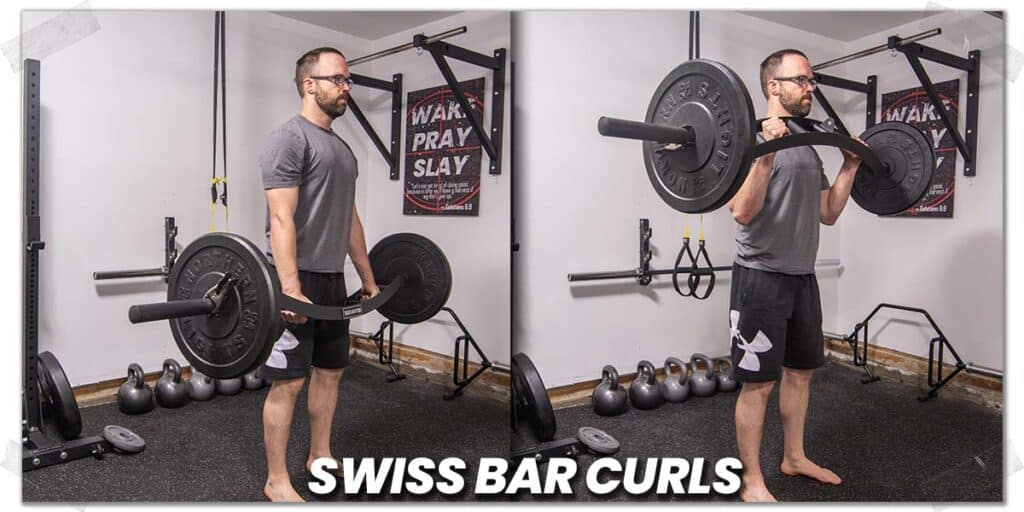
Hammer curls are an arm exercise that can truly build some thick, beefy biceps and forearms. Of course, you can always perform these types of curls with dumbbells, but many lifters often advocate for performing barbell exercises when truly wanting to pack on muscle size and strength; barbell training typically allows for slightly heavier overall loads to be utilized than with dumbbell training.
The beauty of hammer curls is that they target not only the biceps muscle but the brachioradialis as well, which is the large muscle that sits on the top of your forearm.
Bonus tip: If you want to combine two exercises together, you can perform the classic “curl to press” exercise, where you perform a hammer curl and then immediately perform an overhead press once you’ve curled the weight up to your chest.
Exercise 5: Pulldowns*
The Arch Nemesis bar by Bells of Steel is capable of being hooked up to a lat pulldown machine (or similar piece of gym equipment) thanks to a specific attachment piece welded to the top of the bar. To the best of my knowledge, this is the only Swiss bar on the market with this feature.
It’s a rather crafty move by the folks at Bells of Steel since it takes no special engineering or adds any cost to the bar itself and yet provides even more exercise versatility as a result.
With this attachment piece, narrow, medium, or wide-grip pulldowns can all be performed. You could even hook the bar up to a seated cable row and perform horizontal rows since the bar itself is not overly heavy (it only weighs about 20-ish pounds).
Final thoughts
Whatever you want to call this type of barbell, training with a multi-grip bar offers a world of benefits for making you bigger, stronger, and an overall more physically robust human. Swiss bar bench press, multi-grip bar rows — whatever you want to call it and whatever exercises you want to perform — barbell training with a neutral grip will provide more training versatility, allowing you to attack your muscles and build a better body as a result.
Frequently asked questions
Below, you’ll find a few brief answers that individuals often have with Swiss bar training. I hope they are helpful to you!

Hi! I’m Jim Wittstrom, PT, DPT, CSCS, Pn1.
I am a physical therapist who is passionate about all things pertaining to strength & conditioning, human movement, injury prevention and rehabilitation. I created StrengthResurgence.com in order to help others become stronger and healthier. I also love helping aspiring students and therapists fulfill their dreams of becoming successful in school and within their clinical PT practice. Thanks for checking out my site!

